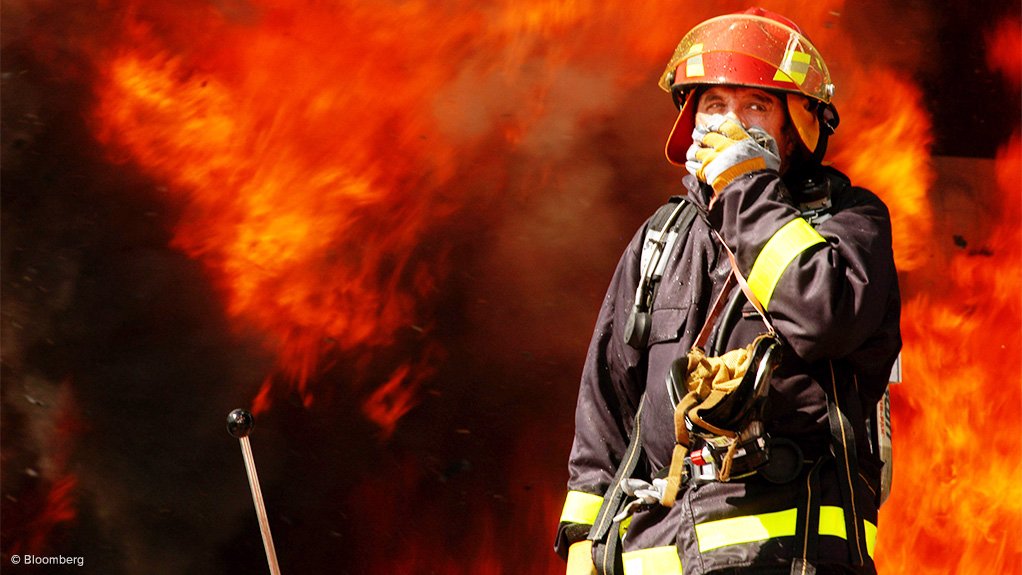TORONTO (miningweekly.com) – Following the unprecedented production interruptions caused by the Alberta wildfires that had taken up to 1.5-million barrels of Canadian crude off the market in May, oil sands major Suncor Energy has advised that it expects to be back to normal operations by the end of June.
The company, which held significant oil sands interests in the worst affected Fort McMurray area in Canada’s oil patch, on Monday confirmed that it was ramping up production in a staged manner and expected all of its operations in the Regional Municipality of Wood Buffalo (RMWB) to be producing at normal, pre-turnaround rates by the end of June.
The wildfires had helped contribute to other global supply interruptions, pushing West Texas Intermediate crude to above the psychologically important $50/bl level on Tuesday.
Suncor expected base plant operations to return to pre-fire production rates within a week. It also expected a return to normal production levels at its in situ facilities and planned turnaround maintenance on the U2 upgrading complex to be completed by the third week of this month.
The company further stated that there had been no damage to its assets as a result of the fires.
Construction activities at Suncor's Fort Hills mine had also returned to pre-fire levels.
Based on current estimates, the 350 000 bbl/d Syncrude operation expected a return to production by late June, with a full ramp-up after completing a scheduled turnaround by mid-July.
As a result of the cumulative impact of the fires on refinery feedstock and a short unplanned outage at one unit of Suncor's Edmonton refinery, gasoline and diesel production had been reduced in Western Canada, resulting in fuel supplies drying up at pumpstations. Suncor expected the unit to be back in service by the end of the week and Suncor was currently working to reduce the supply disruptions to its retail and wholesale customers, it advised.
REVISED GUIDANCE
As a result of the RMWB fires, annualised total upstream production was now estimated to range between 585 000 bbl/d and 620 000 bbl/d, down from 620 000 bbl/d to 665 000 bbl/d expected previously.
Synthetic crude oil sales were now expected to total 265 000 bbl/d to 275 000 bbl/d, down from 290 000 bbl/d to 315 000 bbl/d expected previously, while the exported bitumen guidance of 100 000 bbl/d to 120 000 bbl/d remained constant.
Syncrude production of between 105 000 bbl/d and 115 000 bbl/d (excluding the planned acquisition of Murphy Oil Company's 5% interest in Syncrude), was also expected to be lower, despite the company’s increased stake in the operation.
Suncor advised that, as a result of actual asset performance to date, production guidance for exploration and production had been increased to 105 000 bbl/d to 110 000 bbl/d, up from 95 000 bbl/d to 105 000 bbl/d expected previously.
It said that the costs incurred to respond to the Alberta wildfires were expected to be more than offset by variable cost savings during the outage. Suncor expected cash operating costs per barrel to remain within guidance of $27/bl to $30/bl for the full year. Syncrude cash operating costs were now estimated to climb to between $41/bl and $44/bl for the full year based on the restart timing and production ramp-up.
BOUGHT-DEAL FINANCING
Suncor on Tuesday announced a $2.5-billion bought-deal financing, the net proceeds of which would be used, upon closing, to acquire Murphy Oil's stake in Syncrude and to pay off debt.
The company had agreed to sell 71.5-million common shares from treasury, at a price of $35 a share.
Suncor stated that the deal was expected to provide it with ongoing balance sheet flexibility, including for opportunistic growth transactions that it might identify in the future.
According to the company, it had invested about $9-billion acquisitions and related future development expenditures over the last nine months, resulting in increased, long-life production capacity of about 164 000 bbl/d.
Including the offering, these investments had been funded 60% by issuing scrip and 40% by cash and debt.
The offering would be made through a syndicate of underwriters led by TD Securities, CIBC Capital Markets and JP Morgan Securities Canada.
WILDFIRE STATUS
Meanwhile, several other oil sands operators in the region were also getting their operations back to normal, including Imperial Oil, ConocoPhillips and Shell Canada, which had only seen limited impact by the wildfires.
According to the Alberta provincial government, there was yesterday no significant growth in the Fort McMurray wildfire and the fire was now nearly 70% contained. It was estimated to cover 581 695 ha, including the Saskatchewan side, with a perimeter estimate of 984 km.
However, extreme burning conditions still existed for some areas of the fire, government advised.
There were 2 804 firefighters and support staff, 99 helicopters and 236 pieces of heavy equipment battling fires across the province, with an estimate of about 442 km of dozer guard completed.
Wildfire crews from around the world were supporting Alberta’s efforts, including 299 firefighters from South Africa and 41 from Mexico.
Environmental monitoring continues in the Fort McMurray region. Results of environmental testing data are now available online.
Edited by: Samantha Herbst
Creamer Media Deputy Editor
EMAIL THIS ARTICLE SAVE THIS ARTICLE
To subscribe email subscriptions@creamermedia.co.za or click here
To advertise email advertising@creamermedia.co.za or click here













